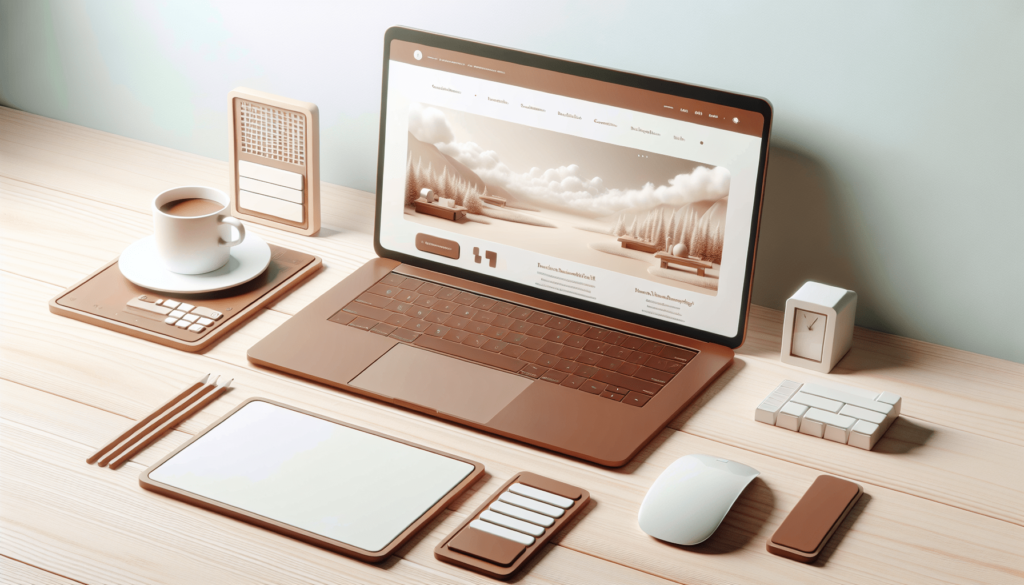Have you ever wondered how to increase conversion rates on your website? One effective strategy to maximize conversion is by implementing minimalist website design techniques. By simplifying the layout, focusing on essential elements, and creating a seamless user experience, you can significantly improve your website’s conversion rate. In this article, we will explore the different minimalist design techniques you can incorporate into your website to drive more conversions and increase your overall success. Let’s dive in!

What is Minimalist Website Design?
Minimalist website design is a design approach that focuses on simplicity and clean aesthetics. It involves removing unnecessary elements, reducing clutter, and emphasizing essential content. By incorporating white space, simple typography, and limited color palettes, minimalist design aims to create a visually appealing and easy-to-navigate website. This design philosophy emphasizes the less-is-more approach, allowing key elements to stand out and capture the user’s attention effectively.
Why is Minimalist Design Effective for Conversion?
Minimalist design is effective for conversion because it eliminates distractions and guides users’ focus towards crucial elements such as call-to-action buttons, product images, and key messages. By reducing visual noise and streamlining the user experience, minimalist design enhances clarity and encourages users to take the desired action on the website. Additionally, minimalist design conveys a sense of professionalism, trustworthiness, and sophistication, which can positively impact users’ perceptions and increase their likelihood of converting.
Key Principles of Minimalist Website Design
To maximize conversion with minimalist website design techniques, it is essential to follow key principles that govern this design approach. These principles include simplicity, functionality, clarity, and user-centricity. By adhering to these principles, you can create a minimalist website that not only looks visually appealing but also drives conversions effectively.
Simplicity
The first key principle of minimalist website design is simplicity. This principle emphasizes the importance of removing unnecessary elements, simplifying complex structures, and focusing on the essential components of the website. By keeping the design clean and uncluttered, you can create a seamless user experience that allows visitors to navigate the website easily and find the information they need quickly. Simplicity also extends to the layout, typography, color scheme, and imagery used on the website, ensuring a cohesive and minimalist aesthetic.
Functionality
Functionality is another crucial principle of minimalist website design. This principle focuses on ensuring that the website is intuitive, easy to use, and performs well across different devices and screen sizes. By prioritizing functionality, you can enhance the user experience, reduce friction in the conversion process, and create a website that is accessible to all users. Functional elements such as navigation menus, search bars, contact forms, and call-to-action buttons should be prominent, easy to find, and simple to use, enhancing the overall usability of the website.
Clarity
Clarity is essential for effective minimalist website design. This principle emphasizes the need for clear and concise communication, logical information hierarchy, and intuitive navigation. By presenting information in a straightforward and understandable manner, you can help users quickly grasp the purpose of the website, navigate through different sections, and locate the desired content. Clear calls-to-action, descriptive headings, and well-organized content can significantly improve the clarity of the website and guide users towards conversion.
User-Centricity
The final key principle of minimalist website design is user-centricity. This principle emphasizes the importance of designing the website with the user in mind, considering their needs, preferences, behaviors, and goals. By understanding your target audience and tailoring the design to meet their expectations, you can create a user-friendly website that resonates with visitors and encourages them to take action. User-centric design involves conducting user research, gathering feedback, and iterating on the design to continually improve the user experience and increase conversion rates.

Best Practices for Minimalist Website Design
To maximize conversion with minimalist website design techniques, it is essential to follow best practices that help you create a visually appealing, user-friendly, and conversion-driven website. These best practices include decluttering the layout, using white space effectively, focusing on typography, optimizing for mobile devices, and testing and iterating on the design.
Decluttering the Layout
One of the fundamental principles of minimalist website design is decluttering the layout. This involves removing unnecessary elements such as excessive text, images, buttons, and links that distract users and overwhelm the visual experience. By simplifying the layout and focusing on essential elements, you can create a clean and uncluttered design that allows key content to shine and captures users’ attention effectively. Decluttering the layout also enhances readability, enhances visual hierarchy, and improves overall user experience, leading to higher engagement and conversion rates.
Using White Space Effectively
White space, also known as negative space, plays a crucial role in minimalist website design. It refers to the empty space between elements on the page, including margins, paddings, and line spacing. By using white space effectively, you can create breathing room around content, establish visual balance, and guide users’ focus towards essential elements. White space also improves readability, reduces cognitive overload, and enhances the overall aesthetic appeal of the website. When used strategically, white space can significantly impact user engagement and conversion rates, making it a critical element of minimalist design.
Focusing on Typography
Typography is another essential aspect of minimalist website design. Choosing the right fonts, sizes, weights, and spacing can significantly impact the readability, accessibility, and visual appeal of the website. Minimalist design often favors clean, sans-serif fonts with ample line spacing and contrast for easy readability. By focusing on typography, you can create a harmonious and cohesive design that complements the overall aesthetic of the website. Typography also plays a vital role in guiding users through the content, highlighting key messages, and strengthening the brand identity, ultimately leading to better user engagement and conversion.
Optimizing for Mobile Devices
With the increasing use of mobile devices for online browsing and shopping, it is essential to optimize your website for mobile responsiveness. Minimalist design techniques can help create a mobile-friendly website that adapts to different screen sizes, touch interactions, and browsing habits. By prioritizing simplicity, functionality, and usability, you can provide a seamless user experience across desktop, mobile, and tablet devices, ensuring that all visitors can access and navigate your website effortlessly. Mobile optimization not only improves user satisfaction but also increases conversion rates by catering to the needs of on-the-go users.
Testing and Iterating on the Design
Continuous testing and iteration are critical for optimizing conversion with minimalist website design techniques. By collecting user feedback, analyzing website performance, and conducting A/B tests, you can identify areas for improvement, refine the design, and enhance the user experience. Testing various design elements such as colors, fonts, layouts, and calls-to-action can help you determine what resonates best with your audience and drives the highest conversion rates. By experimenting with different designs, collecting data-driven insights, and making data-backed decisions, you can continuously refine your website to achieve optimal conversion results.
Case Studies: Successful Implementation of Minimalist Website Design
To illustrate the effectiveness of minimalist website design in driving conversions, let’s look at some case studies of successful implementation. These case studies showcase how businesses have leveraged minimalist design techniques to improve user experience, increase engagement, and boost conversion rates.
Case Study 1: Apple
Apple is a prime example of a company that excels at minimalist design. Their website features a clean layout, intuitive navigation, and minimalist aesthetics that reflect their brand identity. By focusing on simplicity, functionality, and user-centricity, Apple provides a seamless shopping experience that encourages visitors to explore products, learn more about the brand, and make purchases. The use of white space, minimalistic typography, and high-quality imagery creates a visually appealing design that enhances user engagement and drives conversions. Apple’s minimalist website design reinforces the brand’s premium image, instills trust in users, and motivates them to take action, contributing to the company’s overall success.
Case Study 2: Airbnb
Airbnb is another notable example of a company that has embraced minimalist design to drive conversions. Their website features a clean and uncluttered layout, striking visuals, and intuitive user interface that create a seamless booking experience for users. By prioritizing simplicity, clarity, and user-centricity, Airbnb makes it easy for visitors to search for accommodations, filter results, and book stays quickly. The use of white space, minimalist typography, and interactive elements enhances usability, encourages exploration, and guides users towards conversion. Airbnb’s minimalist website design reflects the brand’s commitment to providing a user-friendly and visually appealing platform that encourages trust, engagement, and loyalty among users.
Case Study 3: Everlane
Everlane is a fashion retailer known for its minimalist aesthetic and transparent pricing. Their website features a clean and simple design that showcases products effectively and promotes a seamless shopping experience for users. By emphasizing simplicity, functionality, and clarity, Everlane allows visitors to browse collections, learn about their ethical practices, and make informed purchasing decisions easily. The use of minimalistic typography, high-quality imagery, and intuitive navigation enhances the user experience, builds trust with customers, and drives conversions. Everlane’s minimalist website design reflects the brand’s commitment to authenticity, sustainability, and user-centricity, resonating with their target audience and contributing to their success in the competitive retail industry.
Conclusion
In conclusion, maximizing conversion with minimalist website design techniques requires a strategic approach that emphasizes simplicity, functionality, clarity, and user-centricity. By following key principles, best practices, and case studies of successful implementation, you can create a visually appealing, user-friendly, and conversion-driven website that drives engagement and encourages action. Incorporating minimalist design elements such as decluttered layouts, effective use of white space, typography, mobile optimization, and continuous testing can significantly impact user experience and conversion rates. By leveraging the power of minimalist design, you can create a website that captivates users, boosts conversions, and sets you apart from the competition in the digital landscape. Remember, less is more when it comes to maximizing conversion with minimalist website design techniques!

